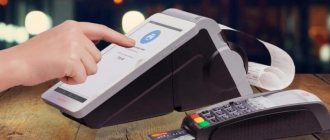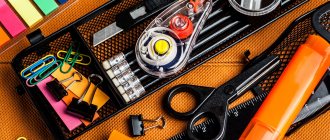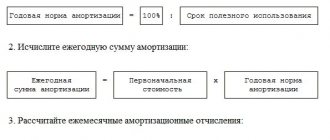Why is classification of fixed assets necessary?
As of January 1, 2017, new OKOF codes came into effect, so it was necessary to make changes to the classification methodology. To calculate the amount of depreciation, the accountant determines the method and useful life of fixed assets; the 2021 classifier will help him with this. With its help, the useful life of fixed assets by depreciation groups is determined. The following legal acts regulate this procedure:
- Decree of the Government of the Russian Federation No. 1 of 01.01.2002;
- Decree of the Government of the Russian Federation No. 640 (clause 2) dated 07/07/2016 - updated classifier of fixed assets 2021 with decoding.
Despite changes in classification methodology, depreciation blocks have not changed.
Classification of fixed assets by depreciation groups
According to the updated system, the distribution of objects, based on their useful life period, is carried out in the following ten blocks:
| Depreciation group | SPI, years | Property objects |
| 1 | From 1 to 2 | Machines, equipment |
| 2 | From 2 to 3 | Machinery, equipment, vehicles, production (household) equipment, perennial plantings |
| 3 | From 3 to 5 | Structures, transmission devices, machines, equipment, vehicles, production (household) equipment |
| 4 | From 5 to 7 | Buildings, structures, transmission devices, machines, equipment, vehicles, production (household) equipment, draft animals, perennial plantings |
| 5 | From 7 to 10 | Buildings, structures, transmission devices, machines, equipment, vehicles, production (household) equipment, operating systems not included in other groups |
| 6 | From 10 to 15 | Structures, transmission devices, housing, machinery, equipment, vehicles, production (household) equipment, perennial plantings |
| 7 | From 15 to 20 | Buildings, structures, transmission devices, machines, equipment, vehicles, perennial plantings, OS not included in other groups |
| 8 | From 20 to 25 | Buildings, structures, transmission devices, machines, equipment, vehicles, production (household) equipment |
| 9 | From 25 to 30 | Buildings, structures, transmission devices, machines, equipment, vehicles |
| 10 | Over 30 | Buildings, structures, transmission devices, dwellings, machines, equipment, vehicles, perennial plantings |
The useful life of a particular property is determined using a classifier established by Decree of the Government of the Russian Federation No. 1. To do this, it is necessary to clarify the depreciation group in which these objects are included and indicate the period (in months) within the range of the established period.
IMPORTANT!
Remember that within the specified interval, the taxpayer independently determines the specific period for each main object.
If the classification of fixed assets by depreciation groups 2020 does not include a specific indicator, that is, the required asset is not included in the groups of the table above, then, according to clause 6 of Art. 258 of the Tax Code of the Russian Federation, the institution independently determines its useful life, based on the technical characteristics or recommendations of the manufacturer.
As a more clear example, we present the first section of the classifier from Resolution No. 1 of 01/01/2002 (as amended in 2021) - the first depreciation group, which includes all short-lived property with a useful life from 1 year to 2 years inclusive.
| Code OKOF | Name | Note |
| 320.26.30.11.190 | Communication equipment, transmitting, with receiving devices, other, not included in other groups | Special tool kits for telecommunications equipment and line-cable works; devices and equipment for operational work in connection with |
| 330.26.51.66 | Instruments, instruments and machines for measurement or control, not included in other groups | Equipment and auxiliary equipment for research in wells |
| 330.28 | Machinery and equipment not included in other groups | Equipment for preparatory work during repair and maintenance of production wells |
| 330.28.1 | General purpose machinery and equipment | Construction and installation tools, manual and mechanized |
| 330.28.12.12.120 | Air motors, rotary air motors, air turbines | — |
| 330.28.13.1 | Pumps for pumping liquids; liquid lifters | Condensate, feed and sand, soil, slurry pumps |
| 330.28.13.24 | Air compressors, mobile, on wheeled chassis | — |
| 330.28.13.28 | Other compressors | — |
| 330.28.22.18 | Lifting, transporting and loading and unloading equipment, other | Mobile scraper belt conveyors; equipment, tools and fixtures, fastening devices for the production and installation of ventilation and sanitary products and products; mechanisms, tools, devices, instruments and devices for electrical installation and commissioning work on equipment for industrial enterprises |
| 330.28.22.18.180 | Loading and unloading equipment for rolling mills, not included in other groups | Rolling steel rolls for section, strip and sheet rolling mills |
| 330.28.29 | General purpose machinery and equipment, other, not included in other groups | Tools for metalworking and woodworking machines; diesel engines and diesel generators with a cylinder diameter over 160 mm (diesel and drilling diesel generators) |
| 330.28.30 | Machinery and equipment for agriculture and forestry | Tools, equipment and means of small-scale mechanization for forestry, forest management and taxation purposes |
| 330.28.41 | Metalworking equipment | Diamond and abrasive tools |
| 330.28.92.1 | Equipment for underground mining | Equipment for various methods of oil and gas production |
| 330.28.92.12.129 | Other tunneling equipment | Jackhammers; mechanized tunnel support; downhole motors and rock cutting tools (for oil wells) (turbo drills, augers, turbo bits, chisels, whipstocks, electric drills, reamers, calibrators and others) |
| 330.28.92.12.130 | Drilling machines | — |
| 330.28.92.12.190 | Other tunneling machines | Machines and equipment for charging and driving blast holes; locks and connecting ends to drill pipes; elements of the bottom drill string assembly; drill locks for electric drills; special drill locks |
| 330.28.92.27.190 | Self-propelled machines for mining, other | Fishing tools for eliminating drilling accidents; tools and devices for cutting off second trunks; drilling tools (except rock cutting tools); a tool for screwing-unscrewing and holding tubing pipes and rods suspended during the repair of production wells; fishing tools for production wells; tool for drilling geological exploration wells; tools for oilfield and geological exploration equipment, other |
| 330.28.92.30.190 | Machinery for excavation and construction, other, not included in other groups | Electric and pneumatic vibrators |
| 330.32.50 | Medical instruments and equipment | Tools for the prosthetic industry |
| 330.32.50.50 | Medical products, including surgical, other | Medical instruments |
Okof Data Storage System
Communication system equipment includes: terminal devices (transmitting and receiving), devices of switching systems - stations, nodes used to transmit information of any kind (speech, alphanumeric, visual, etc.) by signals distributed through wires, optical fibers or radio signals, i.e. telephone, telegraph, fax, telecode communication equipment, cable radio and television broadcasting.
Premises built into buildings and intended for shops, canteens, hairdressing salons, ateliers, rental points for cultural, household and household items, kindergartens, nurseries, post offices, banks and other organizations, the purpose of which is other than the main purpose of the building, includes part of the main building.
OKOF, school automation system
As a general rule, the decision on where to classify material assets (as fixed assets or inventories) is made by the institution.
But according to clarifications from the Russian Ministry of Finance, a video surveillance system does not need to be included in fixed assets. But its individual elements will have to be taken into account as fixed assets.
* We will explain why, and also show you how to reflect these expenses in accounting.
In the situation under consideration, the code OKOF is not defined for the floor turnstile.
Therefore, the institution has the right to establish a useful life based on restrictions other than those established by the Classification of fixed assets, for example, the expected life of use in accordance with technical specifications or manufacturers’ recommendations.
The decision of authorized officials to assign an asset to a particular OKOF code must be based on their professional judgment.
Accordingly, depending on the design of such objects, their principle of operation and technical characteristics, officials of the institution may decide to classify the floor turnstile to the subsection “Machinery and Equipment” - devices that convert energy, materials and information, with the assignment of code 14 3699000 “Other machinery and equipment, not included in other groups.”
Okof hard drive
In accordance with OKOF, external storage devices (code 14 3020340), which include “flash drives,” are included in group 14 3020040 “Peripheral devices and intersystem communication devices of computer complexes and electronic machines,” which in turn is included in group 14 3020000 “ Electronic computer technology.”
Answer: Recently, flash cards - “flash drives” - are storage devices that allow you to store a significantly larger amount of information than floppy disks or computer disks (CDs).
In addition, you can record information on them much faster than on CDs or DVDs, they can be connected via a USB port to almost any modern computer, and thanks to their miniature size, they are easy to carry with you.
Which depreciation group does the computer belong to?
For profit tax purposes, depreciable property is distributed into depreciation groups depending on its useful life (USI).
This period is set by the organization on the date the facility is put into operation, based on the Classification of fixed assets included in depreciation groups (Government Decree No. 1 of 01.01.2002).
In accordance with the Classification, personal computers are classified in the 2nd depreciation group, for which the SPI is established for more than 2 to 3 years inclusive.
We recommend reading: Statement of claim for compensation for road accident damage
A computer is one of the main types of property of an organization, regardless of its industry, scale and other features of its activity.
If a computer in an organization is used for the production and sale of goods (performing work, providing services) or for management purposes and its cost exceeds 100,000 rubles, it is recognized as an object of fixed assets and, therefore, is subject to depreciation (clause 1 of Art.
256, paragraph 1, art. 257 of the Tax Code of the Russian Federation). What is the depreciation group for the computer?
Which depreciation group should the server be assigned to?
The next step for the accountant is to determine the depreciation group of the server. To do this, the accountant must refer to the Classification of Fixed Assets, approved by the Decree of the Government of the Russian Federation dated 01.01.
2002 No. 1. According to this document, the server belongs to electronic computer technology, 2nd depreciation group. This means that the useful life of a company server can be set in the range from 25 to 36 months.
- As an OS - if the server is more expensive than 100,000 rubles. In this case, you need to determine the depreciation group and depreciation method. Thus, accounting for property more expensive than 100,000 rubles. coincides both in accounting (BU) and in tax accounting (TA).
- Property less than 100,000 rubles. in tax accounting, the company does not have the right to depreciate - this is a gross violation of accounting rules (Article 120 of the Tax Code of the Russian Federation). But such property can be classified as material expenses and written off evenly, taking into account its useful life. In this case, when accounting for fixed assets, it is more expensive than 40,000 rubles, but cheaper than 100,000 rubles. NU and BU of the company will coincide.
- The company can write off property worth less than RUB 100,000. to material expenses immediately - this method is convenient to choose if the server costs less than 40,000 rubles. Then the NU and BU will also coincide. Otherwise, temporary differences will arise in accordance with clause 4 of PBU 18/02.
Selecting a storage system
The implementation of hardware in data storage systems (DSS) is similar to the implementation of personal computer architecture. Why, then, use storage systems at all in the architecture of an organization’s local network, why can’t it be provided and implemented on the basis of a regular PC?
In addition to the simple principle - one device, one function ensuring reliability. All main components: power supplies, storage system controllers are duplicated, which of course further increases the reliability of the system, but affects the price of the final product.
Description of types and groups of OKOF (OK 013-2014)
Non-residential buildings can include facilities such as warehouses, garages and industrial buildings, commercial (retail) buildings, entertainment buildings, hotels, restaurants, schools, hospitals, prisons, etc.
The premises of prisons, colonies, pre-trial detention centers, prison barracks, military barracks, dormitories of correctional and educational colonies, medical correctional institutions, schools and hospitals are considered as non-residential buildings, despite the fact that they may serve as a place of residence.
The group “COSTS ON LAND IMPROVEMENT” includes the result of actions that lead to a significant increase in the quantity, improvement in quality or productivity of land, or prevent its deterioration, for example, costs for reclamation work, land clearing, land reclamation, changes in relief (territory planning). These improvements cannot be physically separated from the land itself and do not result in the creation of tangible assets (buildings, structures) that could be shown on balance sheets separately from the land itself.
Requirements for depreciation groups
The most widespread practice is to use a general standard based on dividing fixed assets into single depreciation groups. The most detailed classification, logically related to grouping by age, by natural material, is called the OKOF classification.
We recommend reading: What you need to include a child in your passport
Incorrect OS reflection causes many problems for enterprises.
An important term used in their accounting is “fixed assets,” which include two types of property: tangible and intangible. Fixed assets are the tangible assets of a company.
This conclusion is made on the basis of concepts enshrined in legislative norms.
Meaning of the OKOF code for the printer
When purchasing a new office printing device, the question of how to place it on the balance sheet of the enterprise certainly arises. Confusion often arises regarding MFPs, since these devices simultaneously include a printing device, a fax machine, and a scanner.
The OKOF code for a printer and scanner within one device is selected according to the maximum depreciation group of individual components, in this case we are talking about blueprinting equipment.
Next, we describe in detail how OKOF is selected for new multifunctional office equipment, including the 2021 version of the classifier.
On January 1, 2021, a new classifier of fixed assets came into force, it is also known as OKOF-2.
Accordingly, new coding for fixed assets should be used, while the old classifiers continue to be valid. For quick translation, the OKOF-2 converter is used.
At the same time, the new version also lacks the concept of a multifunctional device, and difficulties arise with coding the equipment.
How to determine depreciation group
During the operation of an object, depreciation is required to be charged on it. In order for deductions to be calculated correctly, the specialist needs to determine the depreciation group of the asset.
Also, in addition to depreciation, the accountant must establish a useful life, that is, the operational period during which depreciation will be charged on the property.
To identify the necessary information, use the classification of fixed assets by groups from RF PP No. 1.
Let's consider two possible situations:
- The main object is presented in the classification by depreciation groups. Information is searched by name or OKOF code. If a specialist has found the asset he needs, he sets the depreciation group and useful life in accordance with the classification. If the position is not found by name, the accountant will continue the search using OKOF and determine the required group.
- If the required item is not in the list of depreciation groups, then the useful life and the depreciation group itself are determined in accordance with the manufacturer’s recommendations, technical data sheet and other documentation of the main property (Letter of the Ministry of Finance of the Russian Federation No. 03-03-06/1/16322 dated 03/22/2017). It is allowed to submit a request for clarification to the Ministry of Economic Development of the Russian Federation or use the uniform standards established by Resolution No. 1072 of October 22, 1990.
IMPORTANT!
Choose your depreciation groups carefully! If a mistake is made, income and property taxes will be calculated incorrectly. After inspections by the tax inspectorate and detection of errors, additional tax payments will have to be added to the budget.
The institution determines its useful life independently, based on its needs for a particular asset in order to make a profit. That is, SPI is equal to the period during which the organization plans to make a profit (clause 4 of PBU 6/01). Moreover, such a period may even be lower than the SPI given in the list of depreciation groups. To secure the useful life of the main property, it is necessary to issue an order, a directive from the head of the institution.
How to calculate depreciation on fixed assets
If the institution has registered property objects and groups of fixed assets, then the accountant is obliged to charge depreciation on a monthly basis, that is, transfer the cost of fixed assets in parts based on their wear and tear. Depreciation deductions are made during the operational period of the main asset, starting from the first day of the month following the month the fixed asset was accepted for accounting (clause 21 of PBU 6/01). In tax accounting, depreciation is charged on fixed assets and their groups from the first day of the month following the month the asset was put into operation (clause 4 of Article 259 of the Tax Code of the Russian Federation). Depreciation charges in accounting are calculated in one of 4 ways - linear, reducing balance, write-off of value in proportion to the volume of goods, work, services, write-off of cost by the sum of the number of years of the joint venture.
In tax accounting, only two methods are used - linear and nonlinear. For data unity, it is recommended that a specialist choose the linear method of depreciation for asset groups for both accounting and tax accounting.
Monthly depreciation charges are determined according to the following formula:
monthly depreciation amount = initial cost of OS / SPI (months).
The institution ceases to form groups of depreciation charges upon disposal of an asset or after full repayment of the cost of fixed assets.
OKOF data collection terminal
The specialization of the store and its format also play a big role, since this is where the requirements for the design of the checkout area are born. For example, for a boutique, the appearance and even color of the equipment plays an important role. In a supermarket, the requirements are aimed at placing the equipment most conveniently relative to the movement of the cashier in the checkout box, thereby increasing the speed and quality of customer service, as the most important indicator of the operation of such a store.
How can you save money when purchasing POS systems by choosing different components (keyboard, monitor, etc.)? The main cost part in any POS system is the fiscal registrar and computer, so savings on peripheral equipment will be insignificant. Typically, the cost of peripheral equipment (cash drawer, barcode scanner) is less than 30% of the cost of the POS system.
How to do accounting
All property assets whose value does not exceed 40,000 rubles are immediately written off as inventories. At the discretion of the accountant, they are registered in the fixed assets group and depreciation is calculated. All objects costing over 40,000 rubles are accounted for as a group of fixed assets. They are subject to monthly depreciation.
All objects valued at 100,000 rubles. and above, in tax and accounting they belong to groups of fixed assets.
At the same time, in accordance with Art. 256 of the Tax Code of the Russian Federation, there is a rule that in tax accounting, property worth 100,000 rubles or more, put into operation after December 31, 2015, must be classified into certain depreciation groups and monthly depreciation must be calculated. Assets worth less than RUB 100,000. written off upon admission to the institution.
All operations with fixed assets groups in budget accounting are reflected in the synthetic account 010100000 “Fixed Assets”. Receipts are recorded in account 0010600000 “Investments in non-financial assets”, disposals are recorded in separate fixed assets accounts ending with 410.
In commercial and non-commercial accounting, transactions with property objects are carried out on account 01, depreciation is recorded on account 02.
OKOF hard drive
If the cost of a flash card exceeds 1000 rubles. (but, as a rule, it does not exceed 10,000 rubles), the accountant should charge a one-time depreciation in the amount of 100% of the book value when the “flash drive” is put into operation, which will be reflected in the accounting entry in the debit of account 1 40101 271 “Depreciation costs of fixed assets and intangible assets" or 2 10604 340 (271) "Increase in the cost of manufacturing materials, finished products (work, services)" (code 271) in correspondence with the credit of account 0 10404 410 "Decrease in the cost of machinery and equipment due to depreciation."
Computers belong to the fixed assets of an institution, since they are tangible objects of property with a useful life of more than 12 months, intended for repeated or permanent use with the right of operational management during the activities of the institution when performing work, providing services, for the exercise of government powers (functions). ) or for the management needs of the institution (clause 38 of the Instructions for the application of the Unified Chart of Accounts, approved by Order of the Ministry of Finance of Russia dated December 1, 2021 No. 157n; hereinafter referred to as Instruction No. 157n). A computer consists of a whole set of components - motherboard, processor, RAM, hard drive, monitor, keyboard, mouse and others. But, let us recall that the object of fixed assets is an object with all the fixtures and accessories, or a separate structurally isolated object intended to perform certain independent functions, or a separate complex of structurally articulated objects representing a single whole and intended to perform a specific job (p 41 Instructions No. 157n). Currently, there are two main approaches to accounting for a computer as a fixed asset:









